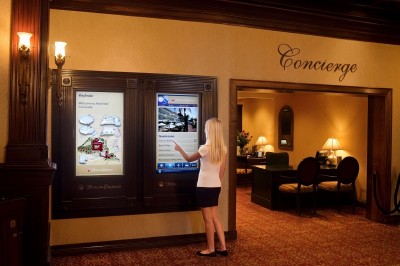By Maria Porco
Wayfinding in large, multi-building facilities has undergone tremendous changes over the years. In the beginning, there were paper-based sign systems. When navigating a convention centre, for example, conference attendees would rely on printed maps and large posters to direct them to their meeting room, while agendas taped up outside rooms would confirm they had arrived at the correct place.
One of the obvious drawbacks of these signs was whenever the information changed, they had to be reprinted and posted, which added to event costs. A less obvious drawback, however, was the essentially one-way ‘conversation’ provided by static signs, which missed out on the opportunity to engage visitors in a more meaningful way.
The introduction of digital wayfinding has addressed these and other drawbacks, providing easier navigation within a facility, savings in time and money related to updates, more capacity for directions and schedules and an improved overall experience for users.
You are here … and beyond
In its most basic form, digital wayfinding starts out with a simple electronic map of an area—similar to those found through Google Maps—and presents it as a static image on a large screen. Labelled with the familiar ‘you are here’ indicator, it allows visitors to situate themselves relative to their desired destination and then find their way.

In Fredericton, N.B., digital signs have been installed for every meeting room within the Fredericton Convention Centre.
The next level of digital wayfinding is an interactive map, which allows users to select their end destination and receive turn-by-turn directions, showing how to get there in a graphical fashion. Interactive maps vary in their level of complexity. The more sophisticated systems provide three-dimensional (3-D) views of the facility, for a better perspective of paths and destinations, making it easier for many users to orient themselves.
Another advance for viewing such maps has been 360-degree panoramic wayfinding. Generally, this involves a touch screen that users swipe to manipulate high-resolution images of locations and amenities, viewing them from any desired angle.
Interactive maps can also provide additional information about those locations and amenities. In some cases, maps are augmented with video and graphical ads from businesses operating in and around the facility, creating an additional source of revenue.
Even an interactive experience does not ensure visitors will remember the directions after they leave the screen, however, so another new trend is to incorporate their own smart phones and tablet computers with the wayfinding system. This way, they can take the map and/or directions with them.
There are several ways this can be accomplished. One is to allow users at a screen to e-mail directions to their own addresses. Another is to display a Quick Response (QR) code on the screen they can scan with their mobile device.






